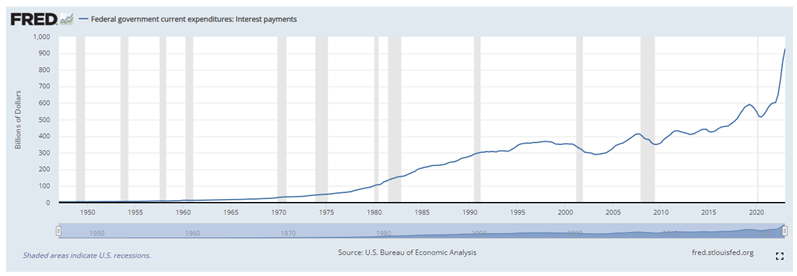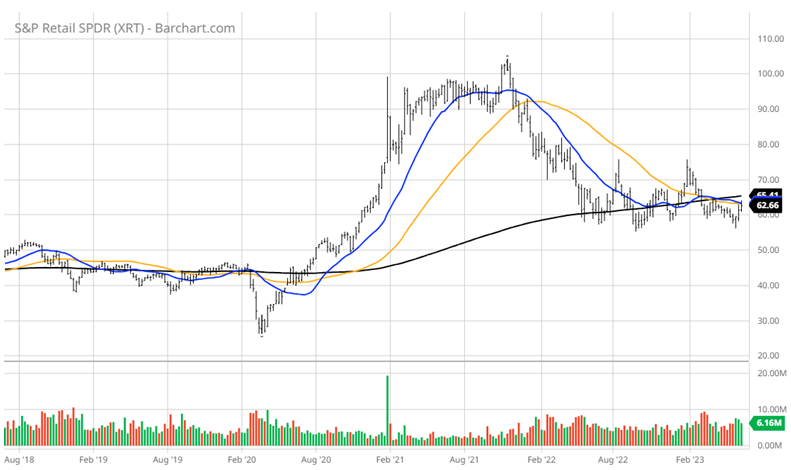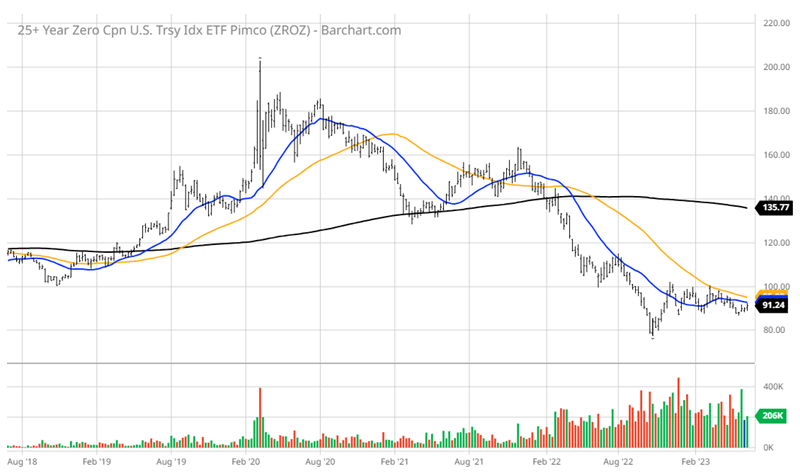by Bryan Perry
June 21, 2023
A few indicators are taking shape within financial markets that indicate it may be time to profit from the bond market as well as the stock market. Let’s start with Fed Chair Jerome Powell noting several inflation indicators moving in the right direction, which, in my view, was a green light for stocks to advance.
The Fed’s stated target for inflation of 2% almost sounds like a pipe dream, given the cost of housing and the strong labor market, but the Fed governors see the cost of interest on the $32 trillion in U.S. federal debt as a looming judgement day for the dollar, if they can’t reign in the cost to carry that debt load until Congress gets religion on fiscal policy. This will only happen, in my view, when fiscally minded leaders on both sides of the aisle agree that doing nothing could cause a historical reset of Biblical proportions.
Interest payments on the federal debt now form a “hockey stick chart” (below), leaping from half a trillion to nearly $1 trillion per year since 2020. This must keep the 400 or so PhDs at the Federal Reserve up at night. I think Powell’s commitment to get inflation back to 2% is rooted in a quote from Albert Einstein: “Compound interest is the 8th wonder of the world. He who understands it earns it; he who doesn’t pays it.”

Graphs are for illustrative and discussion purposes only. Please read important disclosures at the end of this commentary.
If the Fed intends to deconstruct the embedded inflationary forces of the past 18 months, it will have to orchestrate the unemployment rate rising to around 4.5%, which implies the loss of about 1.8 million jobs. This would indeed amplify the notion that the current pause in Fed monetary policy is temporary.
While I agree that inflation is moving in the right direction, the bump in retail sales and consumer confidence data sends a clear message – that despite $17+ trillion in household debt, the reactivation of student loan payments, and credit card rates pushing above 20%, the cheapest average ticket price to see Taylor Swift is $969 in sold-out venues. The highest prices average $20,503 (source: Stubbhub.com).
There seems to be a real disconnect between luxury items and what the average U.S. consumer is facing. Case in point: Home Depot CEO Ted Decker stated in a recent CNBC interview that this #1 home retailer expected to see sales decline by 2% to 5% compared to 2022, and earnings to fall by 7%-13%. Now, to put that news in some context, Home Depot enjoyed an explosion of 47% sales and 60% earnings growth during the pandemic period, so a single-digit pullback makes sense, but not when it’s on borrowed money.
Former Home Depot CEO Bob Nardelli issued a grim warning over the U.S.’s “very complex” economy, cautioning consumers that middle market companies are under “tremendous pressure,” saying, “I think we’re going to see a lot of bankruptcies, like Bed, Bath and Beyond.” (Fox Business News). This is an insightful observation. While the market has rallied on the back of optimism surrounding AI, stocks of specialty retailers have tanked from bearish forward guidance, running counter to market euphoria.
I think the commentary from Costco and Home Depot about consumers shying away from big ticket purchases is somewhat telling about what lies ahead. The chart (below) of the S&P Retail SPDR ETF (XRT) shows a big covid-related spike in spending due to trillions in stimulus checks falling out of the sky, followed by what looks to be a hunkering down of sorts. It argues well that following this summer’s expected spending and travel spree, we’re likely to see the ushering in of a period of belt-tightening.

Graphs are for illustrative and discussion purposes only. Please read important disclosures at the end of this commentary.
Of course, I could be dead wrong and consumer balance sheets may experience some sort of fiscal epiphany – from where, I’m not sure – but I would venture to say that Bob Nardelli is probably on point, and that recent stresses in regional banks and the Fed seeking to break the economy to hammer inflation down to 2% to ameliorate the national debt crisis bodes well for a deflationary cycle and lower interest rates going forward. The Fed failed to recognize inflation in all its fullness early on, and they are now committed to getting it right or they imperil the ability of the country to make good its debt obligations.
Ray Dalio, founder of Bridgewater Capital, the largest hedge fund in the world, stated in Fortune on June 8 that the U.S. is facing a big-cycle debt crisis and that Treasuries are risky. It’s my view that Ray Dalio has an open line to Jay Powell, and they are reading off the same sheet of music. Progressive spending habits are jeopardizing the future of the U.S., and unless both interest rates and government spending come way down, America will go the way of the Roman Empire. It took a long time to wind down, but it ultimately failed monetarily, culturally, and morally. So many people seem jaded by high debt exposure, personally, in business, and at the national level. There seems to be so little emphasis on the future.
And now for the good news. Assuming common sense prevails at some point – and I think it will, at a time when people recognize all that free stuff is no longer coming, because the government is facing a head-on collision with reality – the Fed will orchestrate an economic slowdown that brings rates lower. In doing so, I see an investment proposition that is simply compelling.
About this time a year ago, the 30-year Treasury was yielding around 3.0%. Today, it yields 3.85%. The iShares 20+ Year Bond ETF (TLT) was trading around $118 then, and today it trades at $102.60 as of last Friday. If the long bond gets back down to 3.00%, then shares of TLT should return 15% from current levels. That’s assuming the Fed gets its way with fighting inflation and, with the $31+ trillion debt elephant in the room, I think they will slow the economy to whatever level it takes to break inflation.
For those with an appetite for more risk, the PIMCO 25+ Year Zero Coupon U.S. Treasury ETF (ZROZ) was trading at $110 back in early June 2022, when long bond yields were 3.0% and today it trades at $91.25. A move back from 3.85% to 3.00% would theoretically return 21% in shares of ZROZ. Not bad, considering potentially high-performance alternatives to lofty year-to-date stock market returns.

Graphs are for illustrative and discussion purposes only. Please read important disclosures at the end of this commentary.
If the Fed does in fact achieve its 2% target rate of inflation and long-term rates drop below 3%, then the returns on long-term zeros get into OMG territory, where 50% gains are a plausible scenario.
At this juncture, this is just a “watch list” situation, but when and if the data falls into place, and it may be sooner than we all think, it will make compelling sense to lock and load up on zeros. My view is that the Fed has no choice but to drive rates lower to avert chaos at the governmental budgetary level. In doing so, there is some serious money to be made from a slowing economy by being in the right instruments.
Navellier & Associates owns Costco Wholesale Corporation (COST), and Home Depot (HD) in managed accounts. Bryan Perry does not own Costco Wholesale Corporation (COST) and Home Depot (HD) personally.
All content above represents the opinion of Bryan Perry of Navellier & Associates, Inc.
Also In This Issue
A Look Ahead by Louis Navellier
Muted Inflation News Warns of Potential Deflation Ahead
Income Mail by Bryan Perry
A Time to Consider Locking in Yields?
Growth Mail by Gary Alexander
Buy Some Gasoline to Drive Toward Cleaner Air!
Global Mail by Ivan Martchev
Recession May Still Be Around the Corner
Sector Spotlight by Jason Bodner
The Stock Market is Like…a Lopsided Soccer Game
View Full Archive
Read Past Issues Here

Bryan Perry
SENIOR DIRECTOR
Bryan Perry is a Senior Director with Navellier Private Client Group, advising and facilitating high net worth investors in the pursuit of their financial goals.
Bryan’s financial services career spanning the past three decades includes over 20 years of wealth management experience with Wall Street firms that include Bear Stearns, Lehman Brothers and Paine Webber, working with both retail and institutional clients. Bryan earned a B.A. in Political Science from Virginia Polytechnic Institute & State University and currently holds a Series 65 license. All content of “Income Mail” represents the opinion of Bryan Perry
Important Disclosures:
Although information in these reports has been obtained from and is based upon sources that Navellier believes to be reliable, Navellier does not guarantee its accuracy and it may be incomplete or condensed. All opinions and estimates constitute Navellier’s judgment as of the date the report was created and are subject to change without notice. These reports are for informational purposes only and are not a solicitation for the purchase or sale of a security. Any decision to purchase securities mentioned in these reports must take into account existing public information on such securities or any registered prospectus.To the extent permitted by law, neither Navellier & Associates, Inc., nor any of its affiliates, agents, or service providers assumes any liability or responsibility nor owes any duty of care for any consequences of any person acting or refraining to act in reliance on the information contained in this communication or for any decision based on it.
Past performance is no indication of future results. Investment in securities involves significant risk and has the potential for partial or complete loss of funds invested. It should not be assumed that any securities recommendations made by Navellier. in the future will be profitable or equal the performance of securities made in this report. Dividend payments are not guaranteed. The amount of a dividend payment, if any, can vary over time and issuers may reduce dividends paid on securities in the event of a recession or adverse event affecting a specific industry or issuer.
None of the stock information, data, and company information presented herein constitutes a recommendation by Navellier or a solicitation to buy or sell any securities. Any specific securities identified and described do not represent all of the securities purchased, sold, or recommended for advisory clients. The holdings identified do not represent all of the securities purchased, sold, or recommended for advisory clients and the reader should not assume that investments in the securities identified and discussed were or will be profitable.
Information presented is general information that does not take into account your individual circumstances, financial situation, or needs, nor does it present a personalized recommendation to you. Individual stocks presented may not be suitable for every investor. Investment in securities involves significant risk and has the potential for partial or complete loss of funds invested. Investment in fixed income securities has the potential for the investment return and principal value of an investment to fluctuate so that an investor’s holdings, when redeemed, may be worth less than their original cost.
One cannot invest directly in an index. Index is unmanaged and index performance does not reflect deduction of fees, expenses, or taxes. Presentation of Index data does not reflect a belief by Navellier that any stock index constitutes an investment alternative to any Navellier equity strategy or is necessarily comparable to such strategies. Among the most important differences between the Indices and Navellier strategies are that the Navellier equity strategies may (1) incur material management fees, (2) concentrate its investments in relatively few stocks, industries, or sectors, (3) have significantly greater trading activity and related costs, and (4) be significantly more or less volatile than the Indices.
ETF Risk: We may invest in exchange traded funds (“ETFs”) and some of our investment strategies are generally fully invested in ETFs. Like traditional mutual funds, ETFs charge asset-based fees, but they generally do not charge initial sales charges or redemption fees and investors typically pay only customary brokerage fees to buy and sell ETF shares. The fees and costs charged by ETFs held in client accounts will not be deducted from the compensation the client pays Navellier. ETF prices can fluctuate up or down, and a client account could lose money investing in an ETF if the prices of the securities owned by the ETF go down. ETFs are subject to additional risks:
- ETF shares may trade above or below their net asset value;
- An active trading market for an ETF’s shares may not develop or be maintained;
- The value of an ETF may be more volatile than the underlying portfolio of securities the ETF is designed to track;
- The cost of owning shares of the ETF may exceed those a client would incur by directly investing in the underlying securities; and
- Trading of an ETF’s shares may be halted if the listing exchange’s officials deem it appropriate, the shares are delisted from the exchange, or the activation of market-wide “circuit breakers” (which are tied to large decreases in stock prices) halts stock trading generally.
Grader Disclosures: Investment in equity strategies involves substantial risk and has the potential for partial or complete loss of funds invested. The sample portfolio and any accompanying charts are for informational purposes only and are not to be construed as a solicitation to buy or sell any financial instrument and should not be relied upon as the sole factor in an investment making decision. As a matter of normal and important disclosures to you, as a potential investor, please consider the following: The performance presented is not based on any actual securities trading, portfolio, or accounts, and the reported performance of the A, B, C, D, and F portfolios (collectively the “model portfolios”) should be considered mere “paper” or pro forma performance results based on Navellier’s research.
Investors evaluating any of Navellier & Associates, Inc.’s, (or its affiliates’) Investment Products must not use any information presented here, including the performance figures of the model portfolios, in their evaluation of any Navellier Investment Products. Navellier Investment Products include the firm’s mutual funds and managed accounts. The model portfolios, charts, and other information presented do not represent actual funded trades and are not actual funded portfolios. There are material differences between Navellier Investment Products’ portfolios and the model portfolios, research, and performance figures presented here. The model portfolios and the research results (1) may contain stocks or ETFs that are illiquid and difficult to trade; (2) may contain stock or ETF holdings materially different from actual funded Navellier Investment Product portfolios; (3) include the reinvestment of all dividends and other earnings, estimated trading costs, commissions, or management fees; and, (4) may not reflect prices obtained in an actual funded Navellier Investment Product portfolio. For these and other reasons, the reported performances of model portfolios do not reflect the performance results of Navellier’s actually funded and traded Investment Products. In most cases, Navellier’s Investment Products have materially lower performance results than the performances of the model portfolios presented.
This report contains statements that are, or may be considered to be, forward-looking statements. All statements that are not historical facts, including statements about our beliefs or expectations, are “forward-looking statements” within the meaning of The U.S. Private Securities Litigation Reform Act of 1995. These statements may be identified by such forward-looking terminology as “expect,” “estimate,” “plan,” “intend,” “believe,” “anticipate,” “may,” “will,” “should,” “could,” “continue,” “project,” or similar statements or variations of such terms. Our forward-looking statements are based on a series of expectations, assumptions, and projections, are not guarantees of future results or performance, and involve substantial risks and uncertainty as described in Form ADV Part 2A of our filing with the Securities and Exchange Commission (SEC), which is available at www.adviserinfo.sec.gov or by requesting a copy by emailing info@navellier.com. All of our forward-looking statements are as of the date of this report only. We can give no assurance that such expectations or forward-looking statements will prove to be correct. Actual results may differ materially. You are urged to carefully consider all such factors.
FEDERAL TAX ADVICE DISCLAIMER: As required by U.S. Treasury Regulations, you are informed that, to the extent this presentation includes any federal tax advice, the presentation is not written by Navellier to be used, and cannot be used, for the purpose of avoiding federal tax penalties. Navellier does not advise on any income tax requirements or issues. Use of any information presented by Navellier is for general information only and does not represent tax advice either express or implied. You are encouraged to seek professional tax advice for income tax questions and assistance.
IMPORTANT NEWSLETTER DISCLOSURE:The hypothetical performance results for investment newsletters that are authored or edited by Louis Navellier, including Louis Navellier’s Growth Investor, Louis Navellier’s Breakthrough Stocks, Louis Navellier’s Accelerated Profits, and Louis Navellier’s Platinum Club, are not based on any actual securities trading, portfolio, or accounts, and the newsletters’ reported hypothetical performances should be considered mere “paper” or proforma hypothetical performance results and are not actual performance of real world trades. Navellier & Associates, Inc. does not have any relation to or affiliation with the owner of these newsletters. There are material differences between Navellier Investment Products’ portfolios and the InvestorPlace Media, LLC newsletter portfolios authored by Louis Navellier. The InvestorPlace Media, LLC newsletters contain hypothetical performance that do not include transaction costs, advisory fees, or other fees a client might incur if actual investments and trades were being made by an investor. As a result, newsletter performance should not be used to evaluate Navellier Investment services which are separate and different from the newsletters. The owner of the newsletters is InvestorPlace Media, LLC and any questions concerning the newsletters, including any newsletter advertising or hypothetical Newsletter performance claims, (which are calculated solely by Investor Place Media and not Navellier) should be referred to InvestorPlace Media, LLC at (800) 718-8289.
Please note that Navellier & Associates and the Navellier Private Client Group are managed completely independent of the newsletters owned and published by InvestorPlace Media, LLC and written and edited by Louis Navellier, and investment performance of the newsletters should in no way be considered indicative of potential future investment performance for any Navellier & Associates separately managed account portfolio. Potential investors should consult with their financial advisor before investing in any Navellier Investment Product.
Navellier claims compliance with Global Investment Performance Standards (GIPS). To receive a complete list and descriptions of Navellier’s composites and/or a presentation that adheres to the GIPS standards, please contact Navellier or click here. It should not be assumed that any securities recommendations made by Navellier & Associates, Inc. in the future will be profitable or equal the performance of securities made in this report.
FactSet Disclosure: Navellier does not independently calculate the statistical information included in the attached report. The calculation and the information are provided by FactSet, a company not related to Navellier. Although information contained in the report has been obtained from FactSet and is based on sources Navellier believes to be reliable, Navellier does not guarantee its accuracy, and it may be incomplete or condensed. The report and the related FactSet sourced information are provided on an “as is” basis. The user assumes the entire risk of any use made of this information. Investors should consider the report as only a single factor in making their investment decision. The report is for informational purposes only and is not intended as an offer or solicitation for the purchase or sale of a security. FactSet sourced information is the exclusive property of FactSet. Without prior written permission of FactSet, this information may not be reproduced, disseminated or used to create any financial products. All indices are unmanaged and performance of the indices include reinvestment of dividends and interest income, unless otherwise noted, are not illustrative of any particular investment and an investment cannot be made in any index. Past performance is no guarantee of future results.
